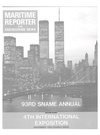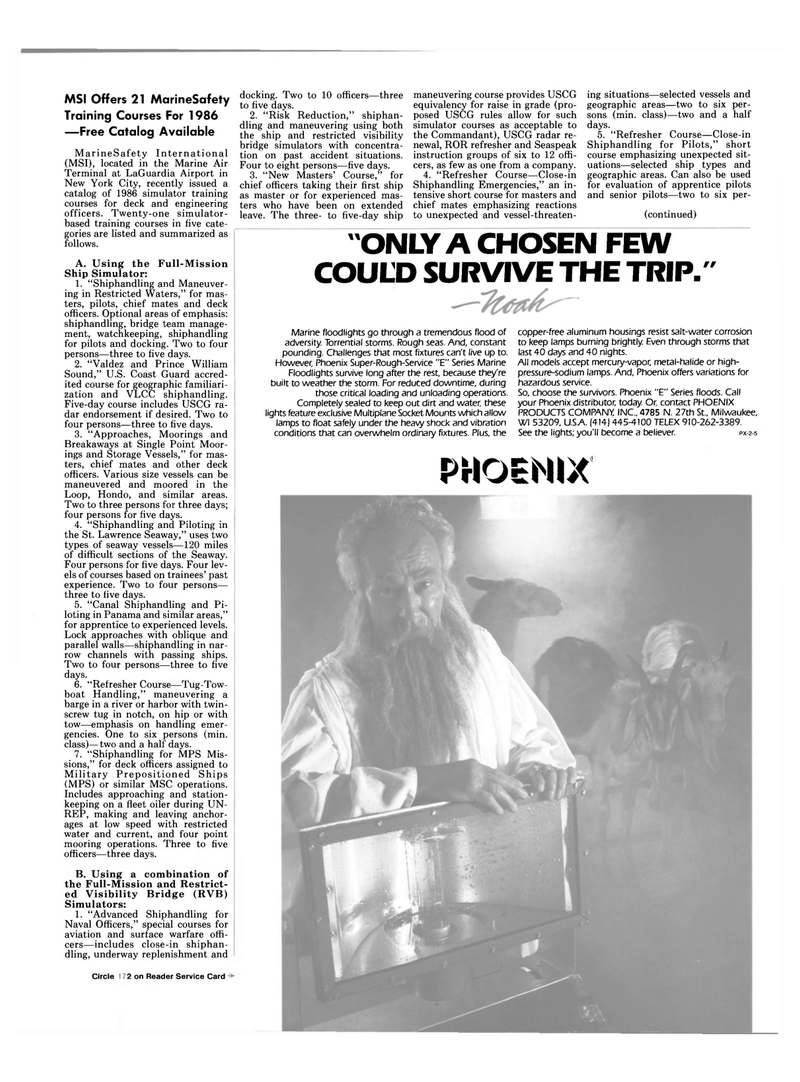
Page 89: of Maritime Reporter Magazine (November 1985)
Read this page in Pdf, Flash or Html5 edition of November 1985 Maritime Reporter Magazine
MSI Offers 21 MarineSafety
Training Courses For 1986 —Free Catalog Available
MarineSafety International (MSI), located in the Marine Air
Terminal at LaGuardia Airport in
New York City, recently issued a catalog of 1986 simulator training courses for deck and engineering officers. Twenty-one simulator- based training courses in five cate- gories are listed and summarized as follows.
A. Using the Full-Mission
Ship Simulator: 1. "Shiphandling and Maneuver- ing in Restricted Waters," for mas- ters, pilots, chief mates and deck officers. Optional areas of emphasis: shiphandling, bridge team manage- ment, watchkeeping, shiphandling for pilots and docking. Two to four persons—three to five days. 2. "Valdez and Prince William
Sound," U.S. Coast Guard accred- ited course for geographic familiari- zation and VLCC shiphandling.
Five-day course includes USCG ra- dar endorsement if desired. Two to four persons—three to five days. 3. "Approaches, Moorings and
Breakaways at Single Point Moor- ings and Storage Vessels," for mas- ters, chief mates and other deck officers. Various size vessels can be maneuvered and moored in the
Loop, Hondo, and similar areas.
Two to three persons for three days; four persons for five days. 4. "Shiphandling and Piloting in the St. Lawrence Seaway," uses two types of seaway vessels—120 miles of difficult sections of the Seaway.
Four persons for five days. Four lev- els of courses based on trainees' past experience. Two to four persons— three to five days. 5. "Canal Shiphandling and Pi- loting in Panama and similar areas," for apprentice to experienced levels.
Lock approaches with oblique and parallel walls—shiphandling in nar- row channels with passing ships.
Two to four persons—three to five days. 6. "Refresher Course—Tug-Tow- boat Handling," maneuvering a barge in a river or harbor with twin- screw tug in notch, on hip or with tow—emphasis on handling emer- gencies. One to six persons (min. class)—two and a half days. 7. "Shiphandling for MPS Mis- sions," for deck officers assigned to
Military Prepositioned Ships (MPS) or similar MSC operations.
Includes approaching and station- keeping on a fleet oiler during UN-
REP, making and leaving anchor- ages at low speed with restricted water and current, and four point mooring operations. Three to five officers—three days.
B. Using a combination of the Full-Mission and Restrict- ed Visibility Bridge (RVB)
Simulators: 1. "Advanced Shiphandling for
Naval Officers," special courses for aviation and surface warfare offi- cers—includes close-in shiphan- dling, underway replenishment and <• Circle 202 on Reader Service Card docking. Two to 10 officers—three to five days. 2. "Risk Reduction," shiphan- dling and maneuvering using both the ship and restricted visibility bridge simulators with concentra- tion on past accident situations.
Four to eight persons—five days. 3. "New Masters' Course," for chief officers taking their first ship as master or for experienced mas- ters who have been on extended leave. The three- to five-day ship maneuvering course provides USCG equivalency for raise in grade (pro- posed USCG rules allow for such simulator courses as acceptable to the Commandant), USCG radar re- newal, ROR refresher and Seaspeak instruction groups of six to 12 offi- cers, as few as one from a company. 4. "Refresher Course—Close-in
Shiphandling Emergencies," an in- tensive short course for masters and chief mates emphasizing reactions to unexpected and vessel-threaten- ing situations—selected vessels and geographic areas—two to six per- sons (min. class)—two and a half days. 5. "Refresher Course—Close-in
Shiphandling for Pilots," short course emphasizing unexpected sit- uations—selected ship types and geographic areas. Can also be used for evaluation of apprentice pilots and senior pilots—two to six per- (continued) "ONLY A CHOSEN FEW
COULD SURVIVE THE TRIP. a
Marine floodlights go through a tremendous flood of adversity. Torrential storms. Rough seas. And, constant pounding. Challenges that most fixtures can't live up to.
However, Phoenix Super-Rough-Service "E" Series Marine
Floodlights survive long after the rest, because they're built to weather the storm. For reduced downtime, during those critical loading and unloading operations.
Completely sealed to keep out dirt and water, these lights feature exclusive Multiplane Socket Mounts which allow lamps to float safely under the heavy shock and vibration conditions that can overwhelm ordinary fixtures. Plus, the copper-free aluminum housings resist salt-water corrosion to keep lamps burning brightly. Even through storms that last 40 days and 40 nights.
All models accept mercury-vapor, metal-halide or high- pressure-sodium lamps. And, Phoenix offers variations for hazardous service.
So, choose the survivors. Phoenix "E" Series floods. Call your Phoenix distributor, today. Or, contact PHOENIX
PRODUCTS COMPANY INC., 4785 N. 27th St., Milwaukee,
Wl 53209, U.SA. (414) 445-4100 TELEX 910-262-3389.
See the lights; you'll become a believer. px-2-5
PHOENIX

 88
88

 90
90
